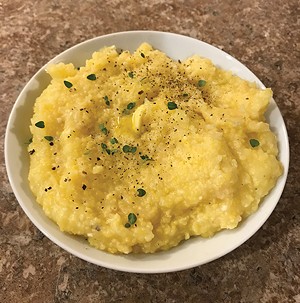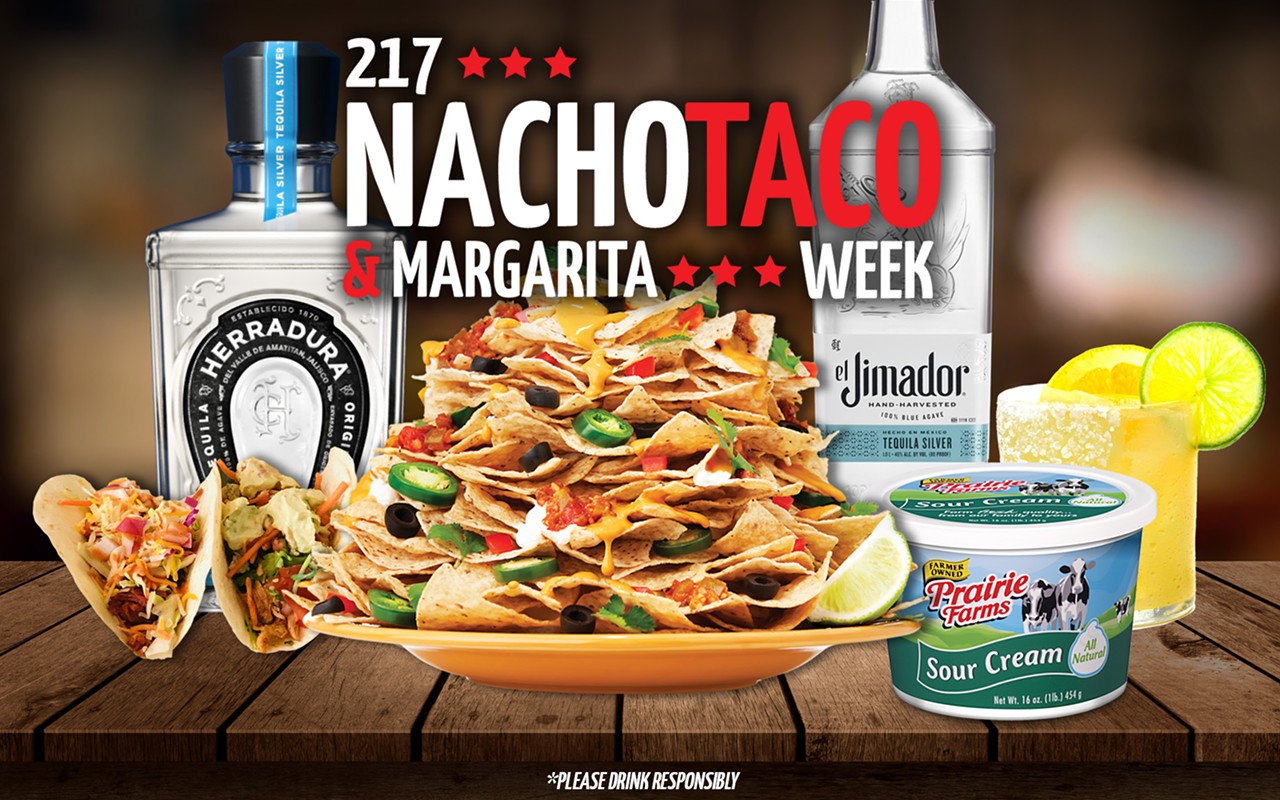When I was a little kid we called it mush. My great-grandma would often make the hot cornmeal porridge for breakfast, served up with a rapidly melting pat of yellow farm butter in the center. Most delicious of all was fried mush: Leftovers would be poured into a loaf pan and refrigerated, then sliced, floured and fried in lard until crispy and golden. Irrationally delicious, it was something we all loved but not exactly the kind of dish you'd serve when company came.
At some point over the subsequent decades American cooks caught on to the Northern Italian preparation of polenta, and today sophisticated iterations of my nana's mush can be found all over restaurant menus and in glossy food magazines. However, unlike the humble dish I remember from childhood, polenta is not limited to breakfast. It can be creamy and laced with parmesan cheese, ready to cradle a saucy piece of meat, chilled and cut into precise shapes for the base of a fancy hors d'oeuvre, or fried until crispy and served with savory marinara.
Nana would have made her mush with regular cornmeal and, while polenta can indeed be made out of any type of cornmeal, it's traditionally prepared with the more coarse stone-ground variety. Corn has gotten a bad rap in recent years and understandably so. Health-conscious cooks know that GMO corn and corn byproducts like high-fructose corn syrup are dietary red flags, commonly found in many highly processed, inflammatory foods.
It could be argued, however, that whole grain, non-GMO cornmeal belongs in a totally different dietary category from its more processed counterparts. Conventional cornmeal is ground on steel rollers and the fiber-rich bran has been removed (because the nutrients contained therein are perishable, removing them improves shelf life) and usually enriched to replace the vitamins that were denuded during processing. Alternatively, stone-ground cornmeal is literally ground between two slowly moving stones, which better retains both nutrition and flavor. For this reason stone-ground cornmeal should always be stored in the freezer to prevent it from going rancid. On its own, a cup of prepared polenta has only 140 calories, four grams of fiber, and three grams of protein, making it a sensible and delicious addition to most balanced meal plans.
Polenta can be prepared and served in a myriad of ways. Ladle mounds of hot polenta onto individual plates or spread the steaming porridge onto a large wooden serving board or platter and top with whatever braised deliciousness tickles your fancy. Known as polenta su tavola throughout Northern Italy, this communal serving method makes for a dramatic and delicious dish that's perfect for dinner parties (remember those?) or a fun night in with the family. Polenta also works as a satisfying alternative to noodles or mashed potatoes alongside a range of dishes, from a meaty tomato sauce to roast chicken or braised pork, saucy shrimp or a savory mushroom ragù.
The versatility of warm, creamy polenta can only be rivaled by the limitless culinary possibilities that are possible with chilled polenta. When spread into a loaf pan or rimmed baking sheet and allowed to set, the once soft polenta becomes firm enough to cut into shapes and used as the foundation for satisfying appetizers or a hearty main course. They can be dredged in flour and fried into crispy morsels, sliced and grilled or layered into casseroles.
Use the basic recipe below as a starting point, and find more ideas for ways to serve polenta in the online version of this article, at illinoistimes.com.
Basic polenta
1 cup dry polenta, or stone-ground cornmeal
4 cups water
1 teaspoon salt
1 tablespoon olive oil or butter
Additional butter and parmesan cheese, to serve
Stove top: Combine polenta, cold water and oil or butter in a heavy-bottomed pot. Whisk thoroughly to combine and bring to a boil over high heat while stirring continuously. Reduce heat to medium and continue to cook, stirring until the mixture has thickened and pulls away from the sides of the pot. (Use caution when working with bubbling hot polenta. It sticks like napalm and burns terribly.) Season to taste with salt and pepper. Add additional butter and Parmesan cheese as desired.
Slow cooker: Spray the insert of a crockpot liner with cooking spray. Whisk together polenta, water and salt and cook on low for three to four hours, stirring two or three times during cooking.
Double boiler: Reduce the amount of water to three cups and bring it to a boil. Place the cornmeal in the top of a double boiler. (You can create a double boiler by setting an appropriately sized metal or tempered glass bowl over a saucepan of simmering water.) Whisk in the boiling water, salt and fat, stirring well to eliminate lumps. Cover tightly and set over simmering water, stirring every five to 10 minutes for the first 30 minutes. Continue to cook for about another hour, stirring twice, until tender and creamy.
MultiCooker: Combine water, polenta, salt and fat in the bowl of the multicooker and whisk to combine. Cook on high pressure for 9 minutes, then let pressure release naturally for 10 minutes before manually releasing the remaining pressure. The polenta will appear a bit thin and unevenly cooked. You will need to whisk it vigorously and loosen the thicker layer that will have formed on the bottom of the pot. After whipping out any lumps, taste and adjust for seasoning, then let it sit for 10 minutes to cool slightly and finish thickening up.
Orange-fennel shrimp and polenta
(Serves 2 hungry people )
1 pound shrimp, peeled and deveined
1 tablespoon olive oil
1 onion, sliced
2-4 cloves garlic, minced
1 large fennel bulb, sliced
1 pint grape tomatoes
½ cup white wine
Zest and juice of one orange
Chopped parsley, to serve
One recipe basic polenta, kept warm
Sprinkle the shrimp with salt. Heat the olive oil in a nonreactive skillet over high heat until very hot but not quite smoking. Sear the shrimp for one minute on heat side, then remove to a plate and set aside (shrimp will not be fully cooked).
Reduce the heat to medium-high then add onion, garlic and fennel to the skillet and sauté until just softened. Add the grape tomatoes and sauté until they begin to burst, then add the wine, orange juice and zest. Continue to cook until the liquid has reduced by half, then add the shrimp and any accumulated juices to the pan. Continue to cook, stirring until the shrimp are fully opaque and cooked through (be careful not to over-cook).
To serve, spoon mounds of warm polenta into the center of your serving plates and arrange the shrimp and fennel mixture over the top. Drizzle with any remaining pan juices, top with chopped parsley and serve.
Polenta Lasagna
A double batch of basic polenta (made with 2 cups dry polenta)
1 pound bulk Italian sausage (or substitute sliced mushrooms)
1 onion, diced
1 green pepper
2-4 cloves of garlic
1 pint cottage cheese
2 eggs
2 teaspoons dried Italian seasoning
1 teaspoon garlic powder
10 ounces frozen chopped spinach, thawed and squeezed dry
16 ounces grated cheese ( I used parmesan and Monterey Jack)
32 ounce jar prepared marinara sauce
Prepare the polenta according to your method of choice. Pour the hot polenta into a rimmed baking sheet that has been lined with foil and coated with cooking spray. Allow it to cool to room temperature then cover and refrigerate for one hour or overnight.
Cook the sausage in a skillet over medium heat till brown. Add the vegetables and cook until softened. Set aside.
Combine the cottage cheese, eggs, Italian seasoning , garlic powder and chopped spinach in a small mixing bowl and set aside.
Preheat the oven to 350 degrees and spray a 9-inch by 13-inch casserole dish (make sure it's deep) with cooking spray. Cut the chilled polenta into four slabs and arrange two of them in the bottom of the casserole dish. Spread half of the cheese mixture on top, then sprinkle half of the sausage mixture followed by half of the marinara and half of the cheese. Arrange the remaining two slabs of polenta on top and then repeat with the remaining ingredients, ending with the shredded cheese. Cover with a greased piece of foil and place the pan on a baking sheet (in case it bubbles over the edges) and bake for one hour, then remove the foil and bake for an additional 30 minutes until golden brown and bubbly. Let rest for 30 minutes before serving.
Tamale Pie
A double batch of basic polenta (made with 2 cups dry polenta)
1 tablespoon olive oil
1 onion, diced
1 red and 1 green bell pepper, diced
1 zucchini, diced
2-4 cloves minced garlic.
2 cans black beans, rinsed and drained
1 cup frozen corn kernels
2 teaspoons cumin
1 heaping teaspoon chili powder (or make it spicy with chipotle chilis in adobo sauce- start with a tablespoon and add to taste)
1 15 ounce jar of your favorite salsa
½ cup chopped cilantro
1 pound shredded cheese of your choice
Chopped green onions and sliced avocado, to serve
Prepare the polenta according to your method of choice. Pour the hot polenta into a rimmed baking sheet that has been lined with foil and coated with cooking spray. Allow it to cool to room temperature then cover and refrigerate for one hour or overnight.
Sauté the onion, pepper and garlic with a generous pinch of salt in the olive oil in a non-reactive skillet over medium heat until softened. Add the cumin and chili powder, then remove from heat and mix in the corn kernels, beans, cilantro, and salsa.
Preheat the oven to 350 degrees and spray a 9-inch by 13-inch casserole dish (make sure it's deep) with cooking spray. Cut the chilled polenta four slabs and arrange two of them in the bottom of the casserole dish. Spread half of the bean mixture over the top, followed by half of the cheese. Top with the remaining polenta and the remaining beans and cheese. Cover with a greased piece of foil and place the pan on a baking sheet (in case it bubbles over the edges) and bake for one hour, then remove the foil and bake for an additional 15 minutes until golden brown and bubbly. Let rest for 30 minutes before serving.
Polenta Fries
Prepare a batch of basic polenta using the method of your choice. Pour the cooked polenta into a foil lined baking dish that has been lightly greased. Allow the polenta to come to room temperature then cover and refrigerate until quite firm, at least one hour.
When ready to fry, turn out the chilled polenta onto a cutting board. Cut the slab in to thick French fry shapes (you can also do wedges or use a cookie cutter).
Season one cup of flour with salt and pepper and place it in a loaf pan or shallow bowl.
Have ready a plate or baking sheet lined with paper towels.
Heat a quarter inch of oil in a heavy skillet with deep sides over medium heat until the oil shimmers and a pinch of flour sizzles when sprinkled into the pan. Working in batches, dredge the cut polenta in the seasoned flour and fry until golden brown, turning halfway to brown both sides. Transfer to a towel lined plate and hold in a warm oven while you fry the remainder. Sprinkle with parmesan and serve with warm marinara sauce.
Ashley Meyer lives in Springfield with her husband, two children, a menagerie of pets and far too many plants.


















